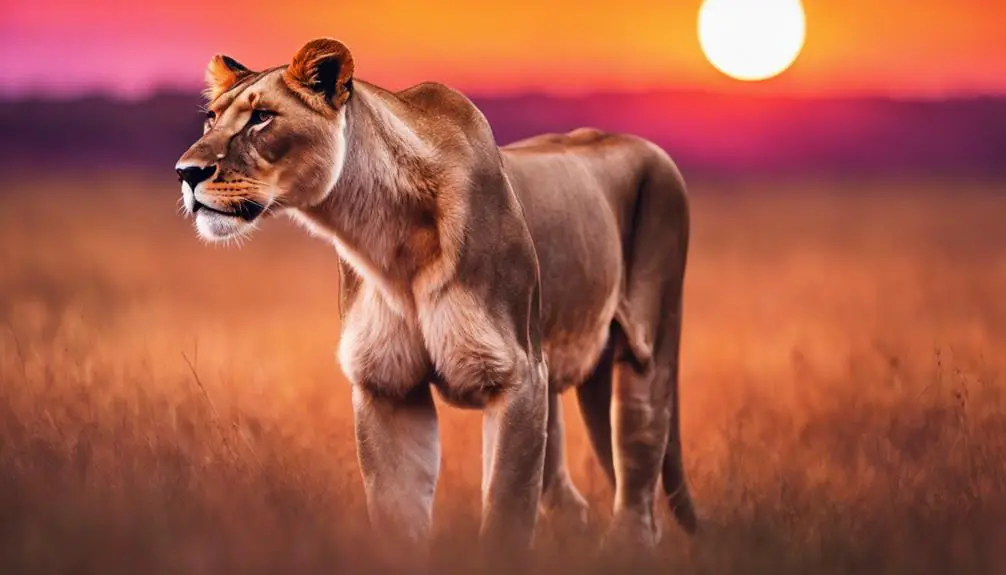Lions are not color blind; they see colors in shades of blue, green, and yellow due to their dichromatic vision. The presence of two types of color receptors in their eyes helps them detect movement and distinguish objects. However, the lack of red-sensitive cones impacts their ability to perceive red hues. Understanding how lions perceive colors sheds light on their behavior and hunting strategies. If you want to know more about how their vision influences their hunting techniques, there’s a lot to discover about their daytime rest patterns and how they utilize moonlight for hunting precision.
Lions Dichromatic Vision
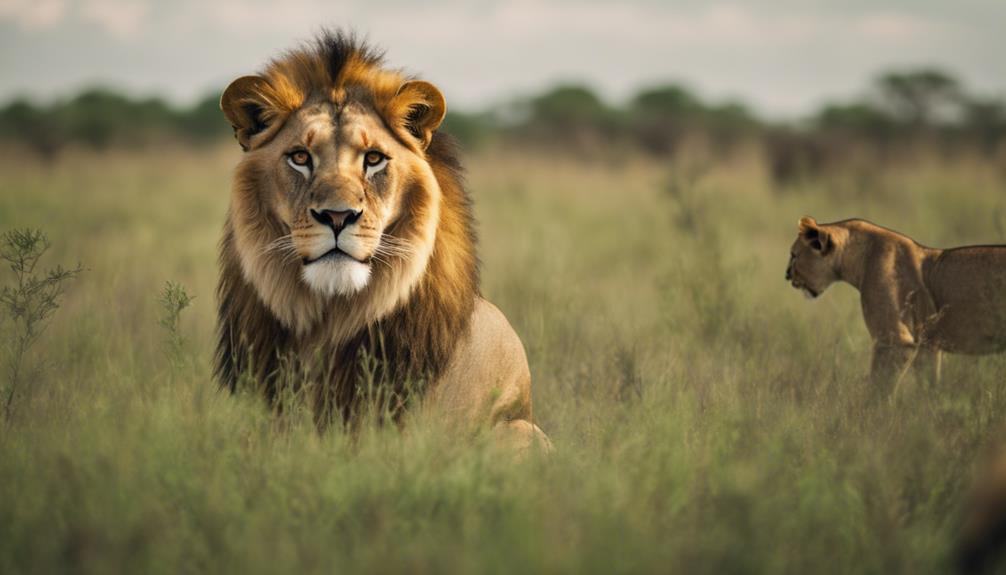
When observing the world through the eyes of lions, one can appreciate their essential dichromatic vision, allowing them to perceive colors in shades of blue, green, and yellow. Unlike humans with trichromatic vision, lions have two types of color receptors in their eyes, limiting their color perception. This dichromatic vision is a unique adaptation that aids them in detecting movement and distinguishing objects in their environment.
Due to this specialized vision, lions excel in hunting during the day when their prey is more active. Their ability to see shades of blue, green, and yellow helps them blend into the savanna landscape, enhancing their stealth and camouflage while stalking their prey. This dichromatic vision also assists lions in differentiating between various textures and patterns, essential for survival in the wild where every detail matters.
In essence, lions’ dichromatic vision, while different from human vision, is perfectly suited to their hunting and survival needs in their natural habitat.
Color Perception in Lions
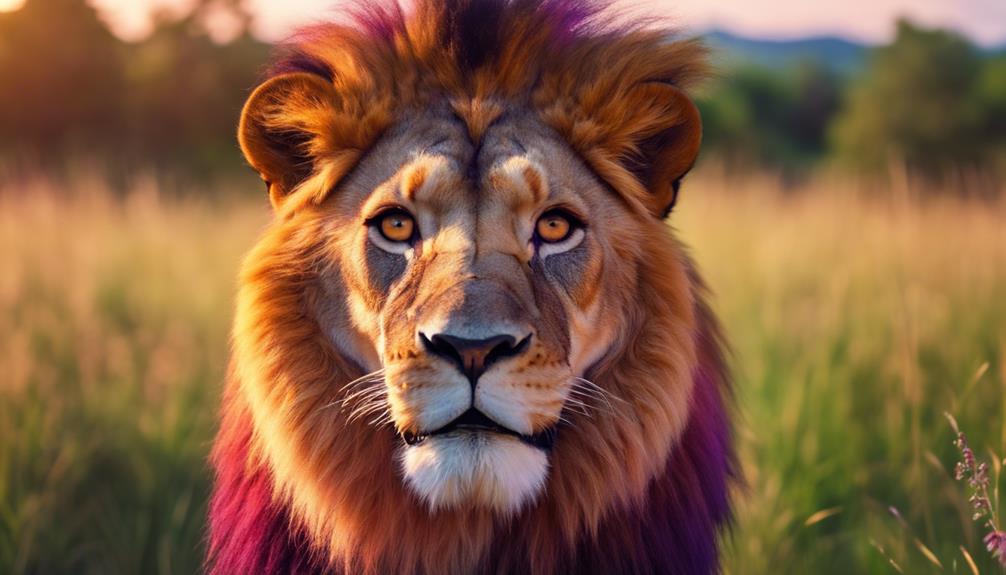
In the domain of the savanna, lions perceive the world in hues of blue, green, and yellow due to their dichromatic vision. This means they’ve two types of cones in their eyes, allowing them to see these colors vividly. Although lions can’t perceive red, they make up for it with their vital ability to detect motion and contrast, essential for hunting and survival in the wild.
Their color perception influences various aspects of their behavior. For instance, the green vegetation and yellow grass of the savanna blend well with their vision, aiding in camouflage while stalking prey. Additionally, the blue sky and greenery help them navigate their surroundings efficiently. Understanding the colors lions see provides valuable insights into how they interact with their environment and the strategies they employ for hunting.
Cone Types in Lion Eyes
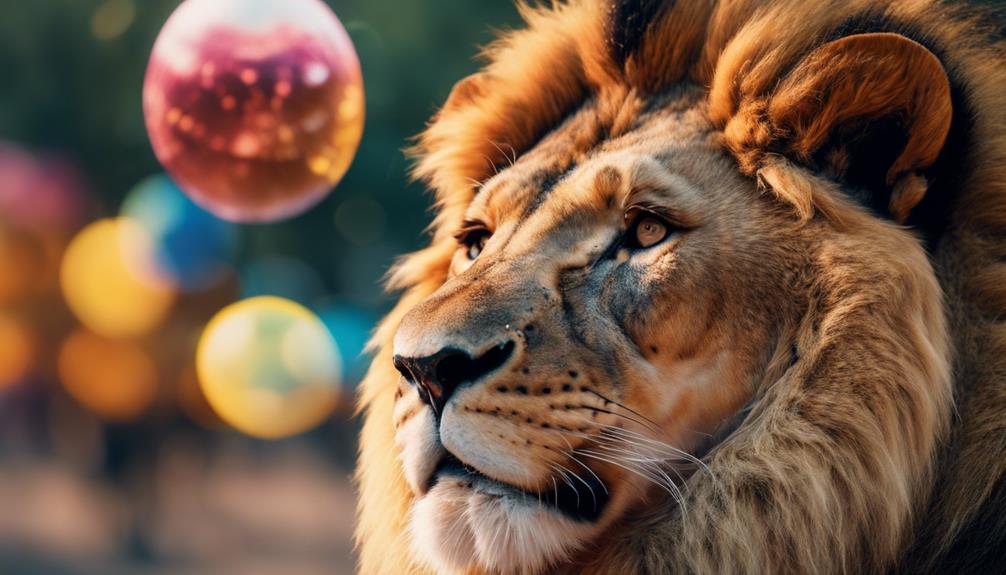
Exploring the intricate biology of lion eyes reveals the fascinating presence of two distinct cone types responsible for their unique color perception. Lions have two main types of cones in their eyes: short-wavelength cones, sensitive to blue light, and long-wavelength cones, sensitive to green and yellow light. These cones allow lions to perceive a range of colors in the blue, green, and yellow spectrum, shaping their view of the world. However, lions lack cones sensitive to red light, making them unable to distinguish the color red from other hues. This unique cone structure influences the colors lions can see and impacts their interactions with the environment.
The presence of these two cone types in lion eyes contributes to their dichromatic vision, providing them with a color perception that differs from humans. Understanding the role of these cones in lion vision helps shed light on how these majestic creatures experience the world around them and navigate their surroundings based on color cues.
Colors Lions Can See
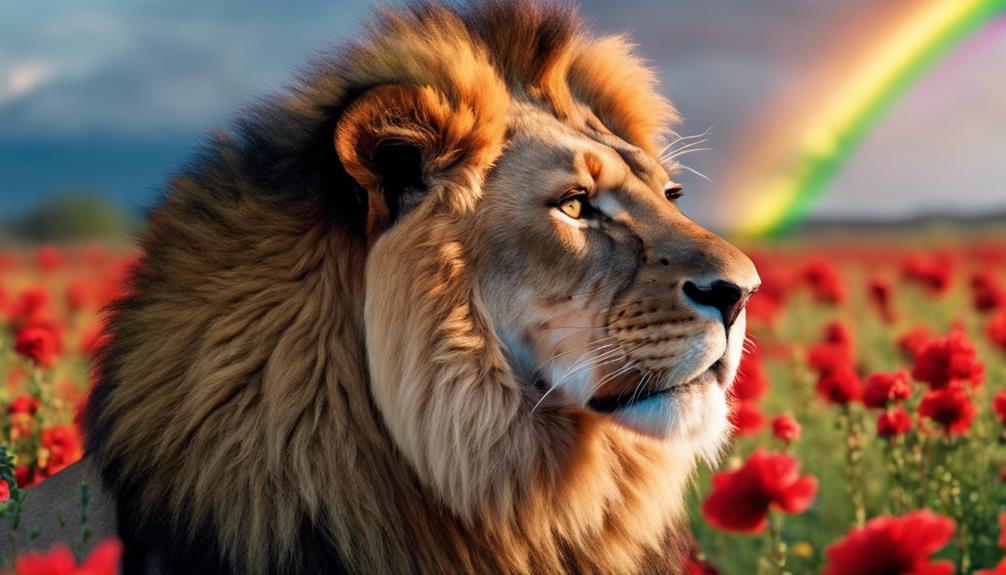
The essential cone structure in lion eyes shapes the colors they can perceive, influencing their interactions with the environment. Lions possess dichromatic vision, allowing them to see a range of colors but with some limitations. They can distinguish between blue, green, and yellow hues, making these colors prominent in their visual world.
However, lions lack the ability to perceive red, so their surroundings appear in shades of blue, green, and yellow tones. These colors play a vital role in how lions identify prey, communicate with each other, and navigate their habitats.
Absence of Red Perception
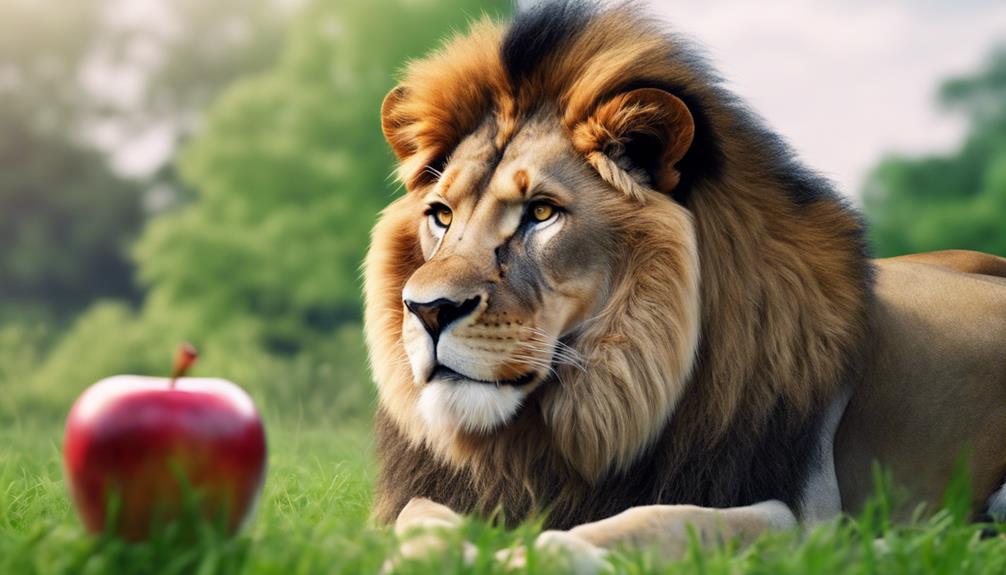
Lions’ incapacity to perceive red colors influences their hunting strategies and social interactions in the wild. While they can see shades of blue, green, and yellow, red appears as a shade of gray to them. This lack of red perception impacts how lions identify prey, as certain animals may blend into the environment due to their reddish coloration. In the wild, this color limitation may lead lions to prioritize movement and contrast over specific colors when hunting.
Furthermore, regarding social interactions, the inability to see red could affect communication within prides. Red coloration in the animal kingdom often signifies dominance or submission. Lions may rely more on body language and vocalizations rather than color cues to establish hierarchy and maintain social order within the pride. Understanding this aspect of lion vision sheds light on their behavioral adaptations and survival strategies in the savanna ecosystem.
Worldview Through Lion Eyes
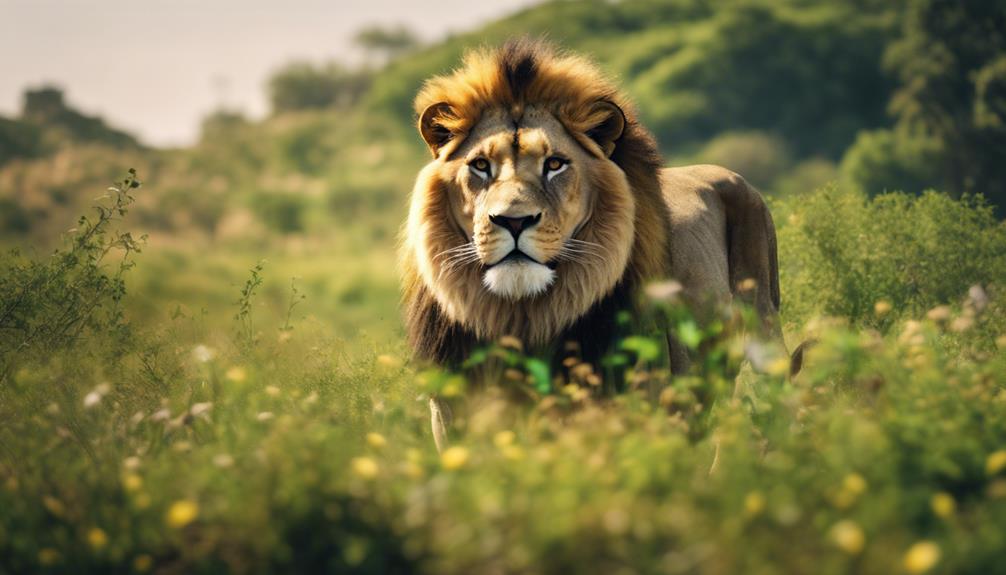
Seeing the world in shades of blue, green, and yellow, lions navigate their environment with a unique color perspective that influences their hunting strategies and social dynamics.
For lions, the absence of red in their color vision shapes how they perceive their surroundings. This limited color spectrum impacts their interactions, as the vibrant red of a sunset or the crimson of blood doesn’t stand out to them. Instead, they excel in detecting movement and contrasts in light and dark hues, aiding them in spotting prey across the savannah.
Their worldview through lion eyes prioritizes these visual cues, allowing them to adapt and thrive in their natural habitat. Understanding this color perception offers insights into the evolutionary adaptations that have honed lions into apex predators, relying on keen senses beyond just color to secure their place in the animal kingdom.
Lions Night Vision
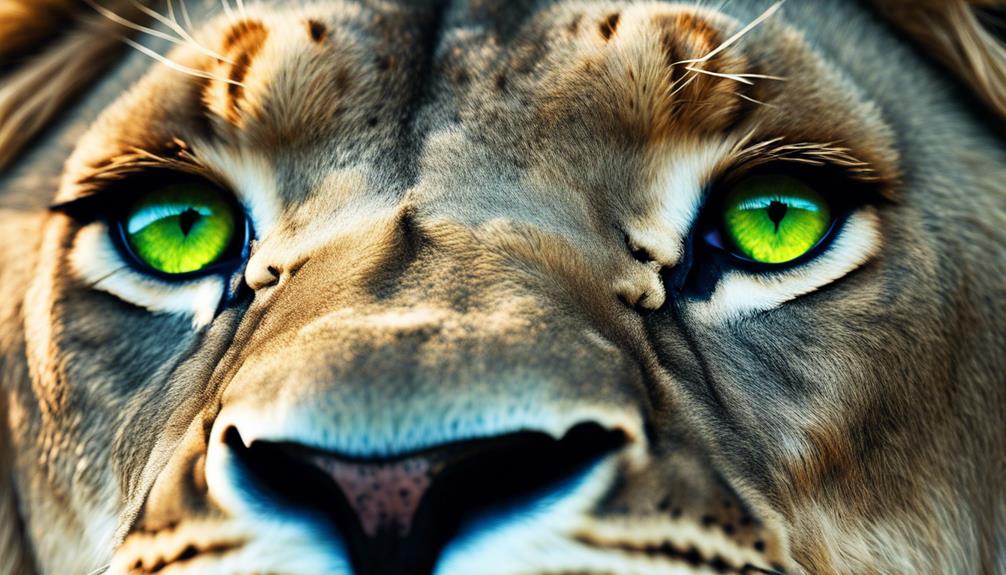
Traversing the shadows with precision, lions leverage their exceptional night vision to thrive in their nocturnal domain. Their ability to see in low-light conditions is attributed to the tapetum lucidum, a reflective layer behind the retina that enhances light sensitivity. This specialized adaptation allows lions to make the most of dim moonlight and starlight, giving them a significant advantage when hunting under the cover of darkness.
Lions’ night vision influences their behavior, making them primarily crepuscular hunters. They’re most active during the twilight hours of dawn and dusk, utilizing their keen eyesight to stalk prey with stealth and precision. This nocturnal behavior not only aids in successful hunts but also helps lions conserve energy during the heat of the day.
With their tapetum lucidum-enhanced vision, lions navigate the darkness with ease, showcasing their prowess as apex predators of the night. This remarkable adaptation underscores their evolutionary success in the wild, positioning them as formidable and efficient hunters under the veil of night.
Tapetum Lucidum Function
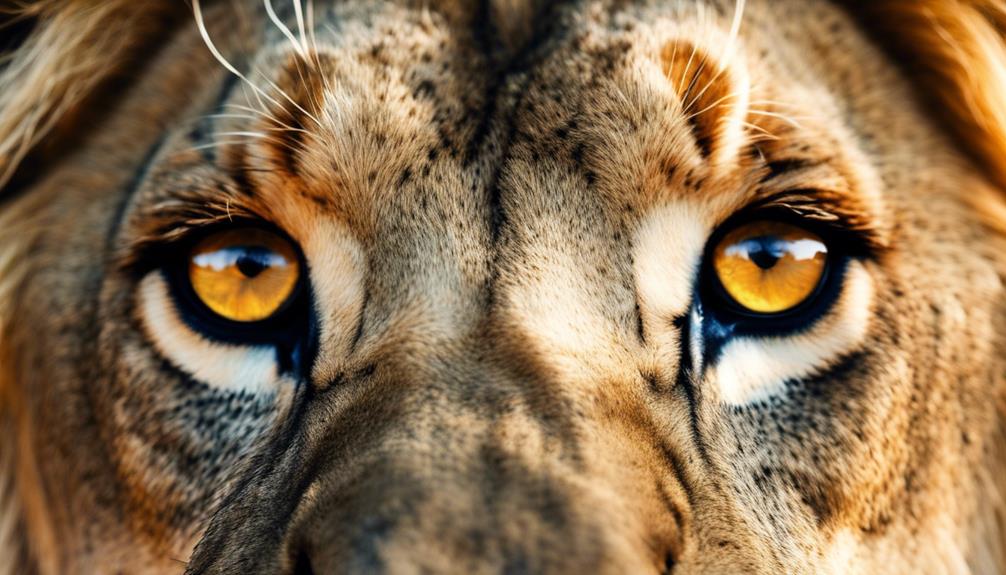
Enhancing the vision of nocturnal animals, the tapetum lucidum serves an essential function in improving light sensitivity in dim environments. This unique layer located behind the retina reflects light that enters the eye, giving it a second chance to be captured by the photoreceptor cells. This reflection enhances the amount of light available for vision, making it particularly advantageous in low-light conditions.
The tapetum lucidum acts like a mirror, bouncing incoming light back through the retina, which can increase light sensitivity by up to 44%. This phenomenon allows lions and other nocturnal animals to see more clearly in the dark than humans, giving them a significant advantage when hunting during the night. The reflective properties of the tapetum lucidum contribute to the glowing eyes effect seen in many nocturnal animals when light is shone on them, aiding in their ability to navigate and locate prey in the darkness.
Low-Light Vision in Lions
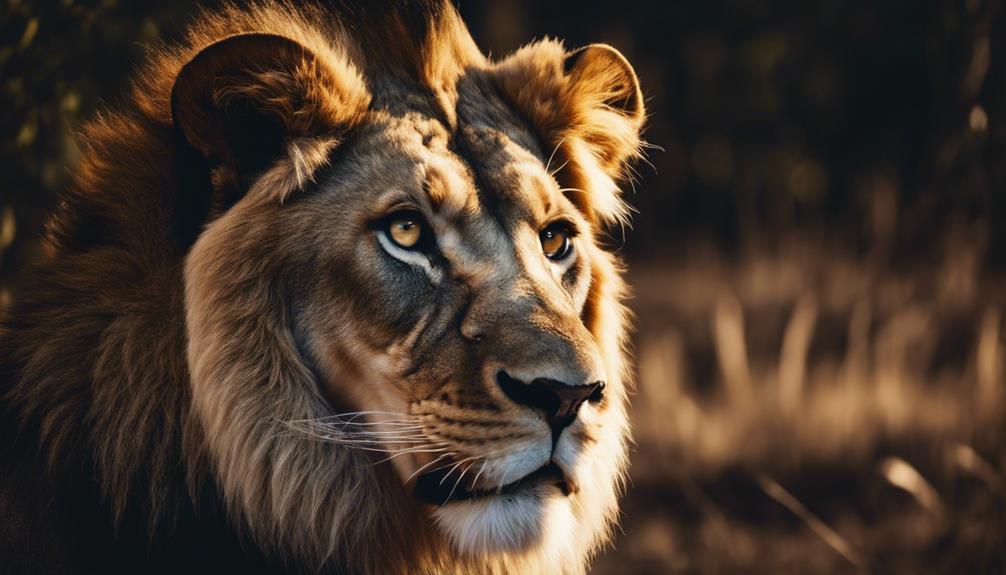
How do lions utilize their superior night vision to thrive in low-light environments?
Lions possess remarkable night vision, thanks to a specialized layer in their eyes called the tapetum lucidum. This layer reflects light that enters the eye, giving the retina a vital opportunity to detect it and enhancing vision in low-light conditions.
The tapetum lucidum acts like a mirror, bouncing light back through the retina, allowing lions to see in conditions where other animals might struggle. This adaptation is essential for lions, as they’re primarily crepuscular, being most active during dawn and dusk when light levels are low.
Nocturnal Behavior in Lions
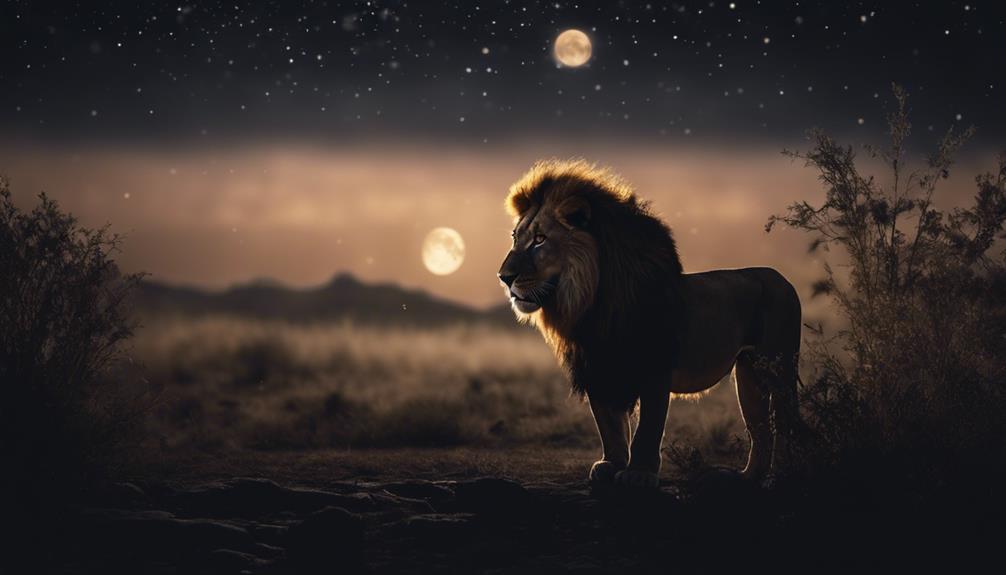
Lions’ nighttime behavior is a key aspect of their survival strategy, shaping their hunting patterns and social interactions in the wild. As mainly nocturnal animals, lions are most active during the night, utilizing their exceptional night vision to their advantage. This behavior allows them to evade the scorching heat of the day, conserving energy for hunting and other essential activities.
During the cover of night, lions exhibit heightened levels of activity, engaging in coordinated hunts to secure prey. Their ability to see in low-light conditions gives them a strategic edge, making it easier to spot potential targets under the moonlit sky. The cover of darkness also aids in their stealth approach towards unsuspecting prey, increasing the likelihood of a successful hunt.
Moreover, the darkness of the night provides a sense of security for lions, allowing them to move around and interact with their pride members without the risk of being easily detected by other predators. This nighttime behavior not only safeguards their survival but also plays an important role in maintaining the balance of the ecosystem they inhabit.
Dawn and Dusk Activity
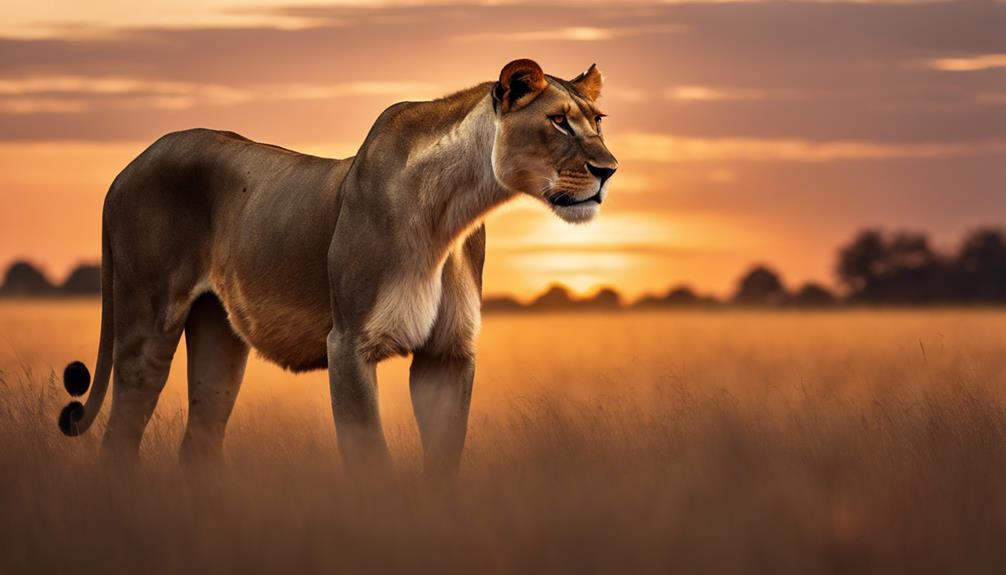
As day shifts into night, the activity of lions at dawn and dusk reveals a dynamic pattern in their behavior. During these changing periods, lions exhibit heightened activity levels compared to the daytime. Dawn and dusk are pivotal times for lions to carry out their hunting activities as they take advantage of the lower temperatures and reduced visibility. The cooler temperatures provide a more comfortable environment for them to move around and hunt without overheating. Additionally, the dim lighting conditions of dawn and dusk offer a strategic advantage for lions, allowing them to stalk and ambush prey more effectively under the cover of twilight.
At dawn, lions are often seen preparing for their day ahead, grooming themselves, and communicating within their pride. As the sun sets, their activity increases, marking the beginning of their hunting expeditions. Lions are known to be crepuscular predators, utilizing the low light levels to their advantage while targeting unsuspecting prey during these changing periods. This unique behavior showcases the adaptability and strategic prowess of these majestic creatures as they navigate the challenges of the savannah.
Daytime Rest Patterns
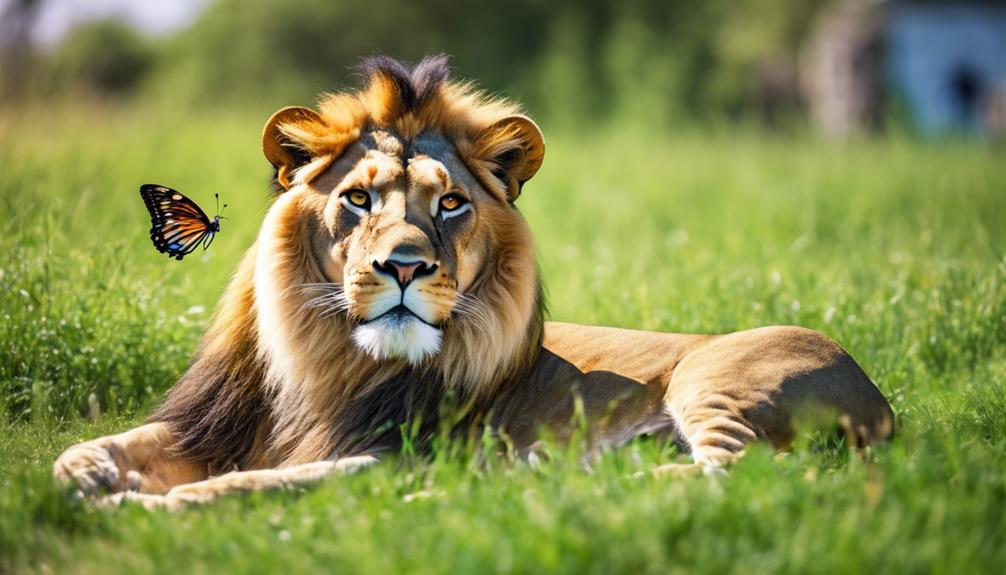
During the daytime, lions typically seek shade and rest to conserve energy for their nocturnal activities. As apex predators, lions have adapted their behavior to optimize their hunting and survival capabilities. Resting during the hottest parts of the day helps lions avoid excessive heat and conserve energy for their evening hunting expeditions. You might find lions lounging under the shade of trees or bushes, often in groups known as prides. This communal resting behavior not only aids in social bonding but also enhances their overall significance and protection against potential threats.
Observing lions during their daytime rest patterns can provide insights into their social structures, communication methods, and individual roles within the pride. It’s fascinating to witness how lions coordinate their resting periods, taking turns to keep watch over the surroundings while others relax and recuperate. Understanding these daytime behaviors is important in unraveling the complex dynamics of lion prides and their strategies for survival in the African wilderness.
Moonlight Utilization by Lions
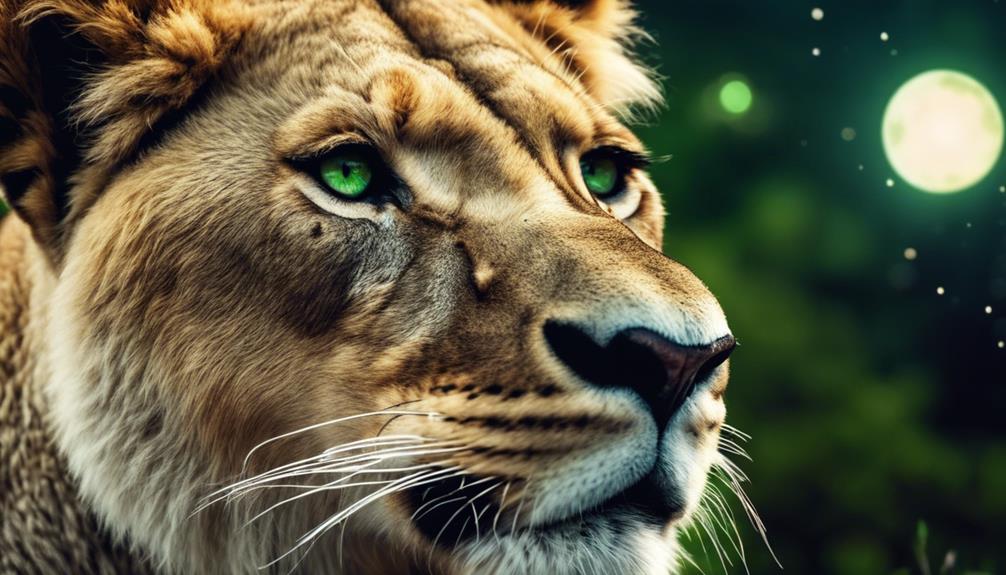
Utilizing moonlight, lions navigate their nocturnal surroundings with precision and stealth, capitalizing on their enhanced night vision for successful hunting expeditions. The moon’s vital glow plays a critical role in aiding lions as they prowl through the darkness, allowing them to move undetected by unsuspecting prey. This natural light source not only illuminates their path but also enhances their ability to spot movements and track down potential targets.
Lions strategically utilize moonlight to their advantage, stalking their prey under the cover of night. The dim, silvery light provides just enough visibility for lions to assess their surroundings and plan their approach with calculated precision. This lunar assistance gives them a strategic edge during the hunt, making it easier to coordinate their movements and execute successful attacks.
Hunting Skills in Lions
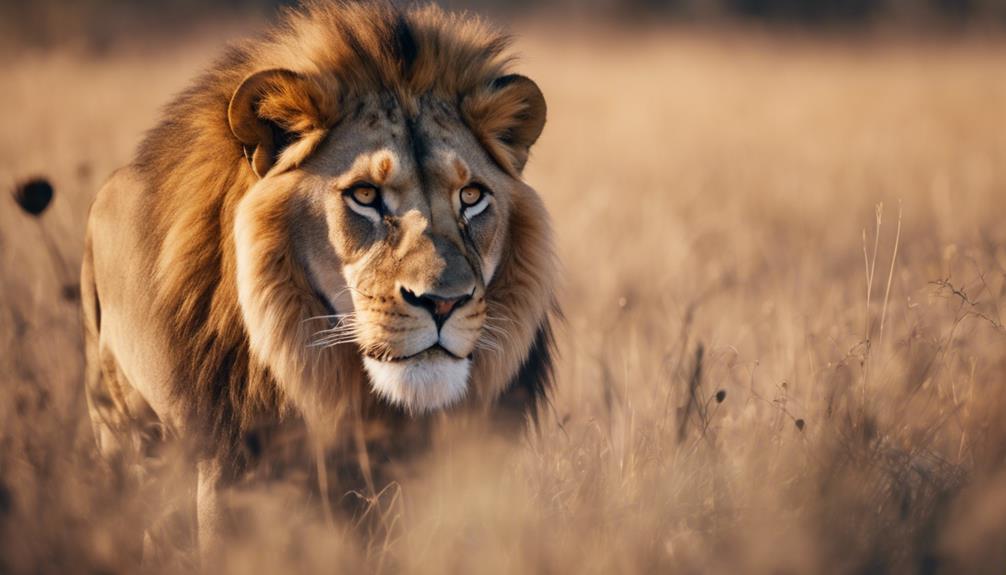
Lions demonstrate exceptional prowess in hunting, showcasing their agility and strategic prowess when stalking prey under the moonlit night sky. Their hunting skills are honed through a combination of teamwork, speed, and stealth.
Working together in coordinated groups, known as prides, lions strategize to approach their prey silently and patiently before launching a synchronized attack.
Their physical attributes, including sharp claws, powerful jaws, and muscular bodies, equip them for successful hunts. Lions rely on a combination of stealth and explosive bursts of speed to catch their prey off guard. Their keen sense of hearing and exceptional night vision aid in tracking and ambushing unsuspecting targets in the cover of darkness.
Intelligence of Lions
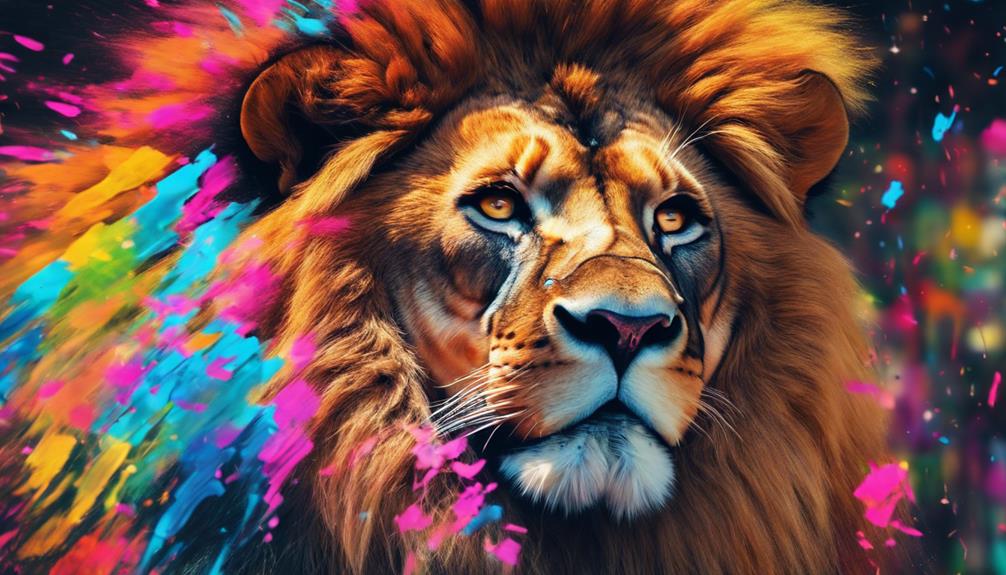
One can appreciate the cunning intellect of these majestic predators as they navigate the intricate dynamics of their social structure and hunting strategies. Lions exhibit remarkable intelligence in their cooperative hunting techniques, where they coordinate with precision to secure prey. Their ability to strategize, communicate effectively through vocalizations and body language, and adapt to different situations showcases their high level of intelligence within their pride. Lions also demonstrate problem-solving skills when faced with challenges such as acquiring food or defending their territory from rival prides.
Furthermore, the social hierarchy within lion prides reflects their intelligence in maintaining order and organization. Leaders within the pride make critical decisions that benefit the collective group, showing a level of foresight and decision-making abilities. The complex relationships between pride members involve intricate social bonds, alliances, and cooperation, indicating a depth of understanding and emotional intelligence among these majestic creatures.

Erzsebet Frey (Eli Frey) is an ecologist and online entrepreneur with a Master of Science in Ecology from the University of Belgrade. Originally from Serbia, she has lived in Sri Lanka since 2017. Eli has worked internationally in countries like Oman, Brazil, Germany, and Sri Lanka. In 2018, she expanded into SEO and blogging, completing courses from UC Davis and Edinburgh. Eli has founded multiple websites focused on biology, ecology, environmental science, sustainable and simple living, and outdoor activities. She enjoys creating nature and simple living videos on YouTube and participates in speleology, diving, and hiking.

